Most of you know I’ve been sewing for more than 40 years. I had an alterations business when I was 15 and the rest is history. I did sort of get derailed a bit during the 80’s when my sewing efforts were limited to churning out garments from handwoven cloth to sell at craft fairs. I used few commercial patterns at that point and so had to sort of re-learn how to use them when I picked up just plain ol’ garment sewing later on in life.
That said, I’d say my pattern company of choice has always been Vogue, the styles, challenges and the way they fit my particular body have always suited me well. And the directions were always flawless. Though I rarely glanced at the first page of the directions sheet, I know how to lay out fabric, and usually in much less space than they illustrate. And I know computers have taken over all of the job of creating those little layouts. And I’m always painfully aware that McCall’s purchased Vogue and Butterick a few years ago. McCall’s was probably my least favorite pattern company for all of the reasons stated above, they were not.
That said, in all of my years of sewing with Vogue patterns I’ve never encountered a serious error in the pattern direction sheets. Maybe I’ve just been lucky. I know some students have written about incorrect directions, but I’ve always contributed that to not understanding the directions, a common problem especially with really complicated garments with 87 pieces. That’s a wholly different issue. Writing technical directions is really really difficult, and no one is completely immune.
What I’m talking about here are glaring errors, that I picked up almost instantly in cutting out this particular Vogue 1320. I do glance at the layout page of the pattern directions initially, since there is usually a reliable guide for which pattern pieces are used for linings and interfacings. Since this pattern has 17 pattern pieces, and I’m cutting the plaid fabric, underlining, interfacing and lining, I always cross check myself by glancing at the layout sheet.
Imagine my shock when I saw this.
When I looked at the list of pattern pieces for the lining, I grabbed all of the ones listed but something didn’t feel right. I carefully looked at the layout and noticed that pattern piece five, for the side of the garment, a pretty large pattern piece, is included in the layout, but not in the list. That could have dire consequences should one cut out the lining and not include pattern piece five, and then not have enough lining to cut it out when it is discovered that pattern piece five is missing from the stack.
Fortunately I caught the error.
I pulled the pieces for cutting the interfacing, a woven sew-in, and noticed that the interfacing for the hem and sleeve hem are cut on the bias. That’s pretty standard for a tailored garment. What shocked me was the layout drawing for the interfacing. There is no acknowledgement of the bias for pieces 16 and 17, in fact the pieces are cut on the straight of grain in the layout.
Fortunately I caught this error as well.
What makes me sad here, is that the one stalwart of accuracy I’ve always counted on was the pattern industry. Naive I know. I’m skilled enough to find things like this and work around them, but many of my students are not. That’s really sad. And these kind of errors can cause huge repercussions because a straight grain hem facing will never lay right. And a missing side lining piece can’t be pulled out of thin air if it wasn’t cut out initially and there is no more fabric.
So after much mourning for the loss of the dependable pattern company directions, and a nice bottle of red wine, I cut out my plaid, lining, underlining and interfacing and stacked all the patterns in order of construction sequence. I always smile when I tell a student that patterns are numbered in order of sequence of construction and they look at me with a huge light bulb turning on, I’m surprised at how many people don’t know that. Stacking the pattern pieces numerically means they are ready to sew in the sequence of construction.
The first step after mounting the underlining and stay stitching is of course bound buttonholes. Since this is a plaid, and I’m a little OCD, matching is important to me, and one of the tricks I learned back in High School was to cut the strip for the buttonhole lips on the bias so no plaid matching is necessary.
I also have a small stash of Bakelite buttons, and this is one of the choices. I’ll ultimately decide once the garment is finished, but the buttonholes are now made, at least in the front, (there is still one to do on the yoke) and I’ve got the sides attached with pockets and I’m enjoying the sequence of this garment, because it is an Issey Miyake pattern and they always guarantee a wild ride…
Stay tuned…
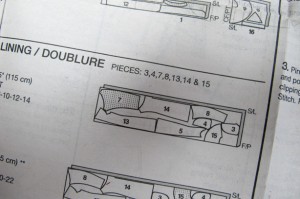
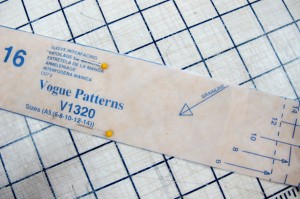
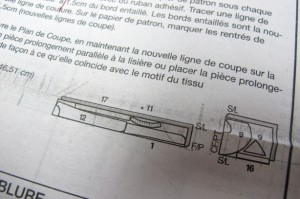
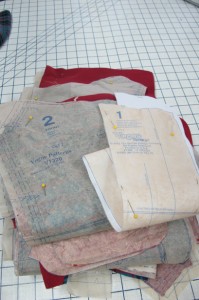
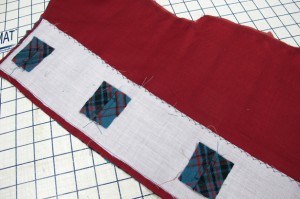
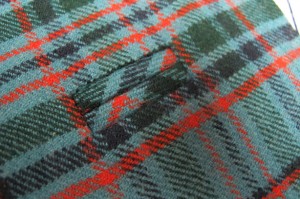
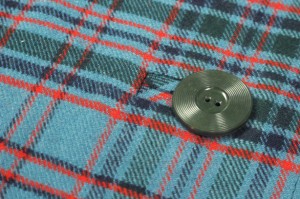
Interesting………..I too did not know pieces were numbered for sewing order! I was having a ‘problem’ figuring out a vogue Marci Tilton pants pattern and had to keep walking away and rethinking. A friend said don’t they have errata sheets? HA I did figure it out but could have made a smaller size…….numbers ARGHHH So now I am starting with Silhouette patterns and we wills see how that goes.
I LOVE your bound buttonholes! I am staying tuned 🙂
did you notify Vogue about the problem? I think they need to know for the sewers who are not experienced to know. I know I would appreciate it! they can correct the next printing if they make one or put it on their website.
Another light bulb moment here too. I rarely have to search so I must do it intuitively – but what a great tip!
The more I think about it the more I believe they should do more than add a correction to a website. Who goes to a website to check each and every pattern for corrections? They either need to put corrections in every Vogue 1320 pattern they have out there or they need to pull them all and reprint. The same goes for any pattern with that kind of gross error(s). Can you imagine if we were using our precious handwoven material? Just try to come up with that much more! Piece 5 of that pattern is not only large, you… Read more »
I did not know pattern pieces were numbered for a particular purpose. I love your buttonholes and your plaid fabric. Can’t wait to see the finished piece. I don’t sew, but I did make a vest in one of your classes and were it all the time. Thank you for all your helpful information.
Since I neither use the provided layout nor necessarily sew things in the given order, I may not have noticed the errors. Good catch! And on an Issey Miyake pattern too. So sad.
Just shows you, one needs to pay strict attention and think things through before leaping in with the scissors (or rotary cutter). And also note that none of the commercial patterns are to be trusted implicitly! How frustrating. Now I feel sorry for newbie sewers everywhere.
How very sad that those mistakes were made. Now I have sewn for um 60 years and duh, no one told me about the numbers (but I am an ole lady dog still learning new tricks). Yes, you need to send Vogue, McCalls or whomever a detailed letter with your experience and also get a (what da ya call it) and you have to pay for it–a card they sign saying they got the letter. Ole Lady Dog has just had a ………..Must be the cough and cold. Why are we the ones who have to watch out for everything?… Read more »
How fun is that? I’ve sewn garments for more than 35 years. Never did a Home Ec. teacher mention the pattern piece number/construction order correlation. I’m currently setting up a sewing room/weaving spinning studio, and will be teaching my daughter to sew. I’ll get to be the “Old dog with a new trick”! thank you!
Daryl, I too have been sewing for many years – about 50. I had an alterations & seamstress shop at age 16. Began sewing for others at 13.
This seems like a fun coat. Thanks for the review & alterations to the instructions.
SewingQueenKym
Evening Daryl, I found your blog whilst googling errors on Vogue patterns! I used Vogue patterns back in the 1980’s and have just returned. The first two garments I make both have errors in the instructions and one has a pattern piece that is clearly larger than it should be with the notches mismatched.
I’ve been over and over it, and I just have to adjust the pattern piece myself. It’s lucky I’m an experienced sewer otherwise I would have been in real trouble with possible wasted work & fabric.